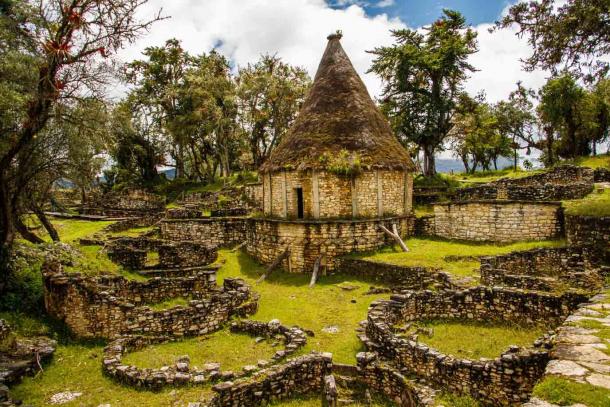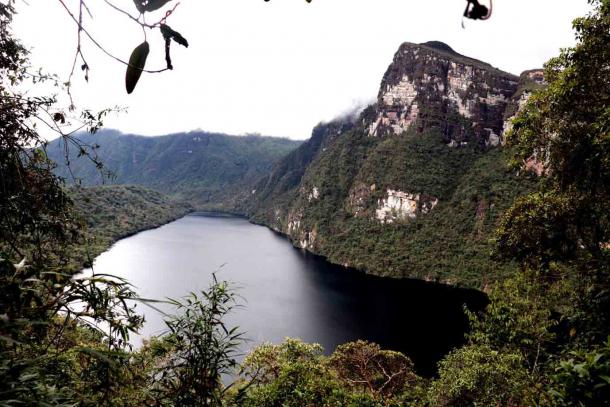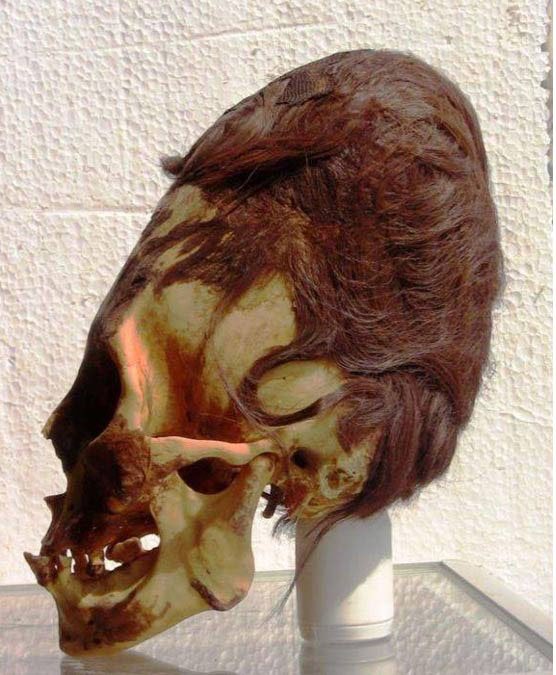Over a thousand years ago, in the mists of the cloud forests of northern Peru, near the source of the mighty Amazon River, the Cloud Warriors reigned supreme. Long before the emergence of the Inca State , these mysterious, shamanic warlords ruled a vast swath of the Andes before being defeated by the Inca, abandoning their great citadel, and vanishing into history. In recent decades, additional archaeological evidence has come to light from two primary sources, the fortress city known as Kuelap, and the cliff face necropolis at the Lagoon of the Condors. Because these cultures left no written records (that we’re currently aware of), the only sources of information relating to them were native, oral traditions, and documentary accounts by early European explorers, which has lead to centuries of speculation and controversy.
Kuelap and the Lagoon of the Condors
Rising up nearly ten thousand feet (3,048 m.) above the Utcubamba Valley, surrounded by clouds, orchids, and epiphytes, the walled settlement of Kuelap dominates the landscape. Sometimes called the Machu Picchu of the North, Kuelap is an underrated wonder of the ancient world. The perimeter walls of the settlement are sixty feet (thirty meters) high, protecting over four-hundred circular dwelling structures which originally had thatched conical roofs, which is absolutely anomalous in pre-Columbian architecture. There are many other features unique to Andean civilization, like the twenty-foot (7 m.) tall defensive towers from which stone spheres were used as projectiles from slings.
In 1997, about 500 miles (805 km) to the north of Kuelap, over two hundred mummies were discovered high in the cliffs around this remote lake. The mummies were wrapped in seated positions and sealed within individualized, anthropomorphic sarcophagi overlooking the lake, all of which is highly abnormal amongst Andean cultures. Many of the mummies had been looted, and some had strange cranial features such as elongated skulls or holes from trepanning (a premortem cavity drilled into the skull). Kuelap also had human skulls embedded within the walls, which also displayed stone sculptures of decapitated victims.
The two hundred mummies discovered at the lake were astonishingly well preserved considering how humid the region is. Scientists later discovered that the caves and crags that the Cloud People modified in mausoleums are very cold and dry microclimates, perfectly suited for long term preservation. Scores of human remains, artifacts, and biological remnants were discovered at Kuelap, including hallucinogenic plants, sacrificial animal bones, and stone weapons.
Evidence of violence and fire were discovered at Kuelap, random age and gender skeletons were discovered in scattered, open locations, suggesting they were not interred there, but rather, that they died suddenly in that spot. The two-hundred and thirty mummies are now quietly kept at the Museo Leymebamba, but the remains and artifacts from Kuelap are not being displayed, publicly studied, and their exact location is unknown.

Archaeological remains, including a reconstructed circular dwelling, at Kuelap in Peru, a walled settlement built by the Chachapoya culture. ( LindaPhotography / Adobe Stock)
Controversies Regarding the Origins of the Chachapoya Cloud Warriors
The Routledge Handbook of the Bioarcheology of Human Conflict quotes the European chronicler Pedro Cieza de Leon’s 1553 description of the Cloud People:
“Among the Chachapoya Huayna Capac (an Incan ruler) met great resistance, so much that twice he had to make hasty retreat to the fortresses he had built for defense. But with reinforcements brought to him, he marched on the Chachapoyas once more and inflicted such a defeat on them that they sued for peace and laid down their arms. The Inca granted them favorable terms and ordered many of them to take up their residence in Cuzco, where their descendants still live; he took many of their women because they are handsome and comely and very white; he set up garrisons of mitimaes as soldiers, to guard the frontier .”
This description, combined with several others, the anomalous and Old World nature of their architecture and funerary practices, have lead to many theories that the Chachapoya originated in Europe or Eurasia.
Hail to Independent Researcher #1: Dr. Hans Giffhorn
In 1998, German professor Dr. Hans Giffhorn journeyed to the remote cloud forests of northern Peru in search of a rare hummingbird, but left bewildered by what he had seen: the ruins of Kuelap. In his essay “Chachapoya: Was America Discovered in Ancient Times,” Bell explains how Giffhorn reasoned the most irrefutable hypothesis for the Chachapoya having migrated from the Old World.
Giffhorn identified six complex and typical cultural traditions which appeared out of nowhere, which are inadequately explained by archaeologists and which are essential to testing theories regarding the origins of Chachapoya culture. They manifest in a) Kuelap construction methods, b) trophy heads and head sculptures, c) funerary (fetal positioning and high up in inaccessible cliffs), d) unique trepanation techniques, and e) the fabrication and utilization of stone projectile slings.
After sixteen years of research, Giffhorn found strong evidence linking the sudden, aboriginal emergence of Chachapoya Culture to Old World Cultures that matched the previously mentioned criteria. Specifically, he reasoned that these practices mirrored Galacian, Celtiberian, and Balearic traditions. Even the casual observer can make the obvious connection between the Celtic Castros Ruins of the Spanish Islands to these ruins in Northern Peru; furthermore, the principal weapon of both cultures was the sling and stone sphere projectile.
According to mainstream archaeologists, the sling first emerged in South America at this time and in this region, and the pattern runs much deeper, circular stone dwellings, towers, trepanation, elongated skulls , these aspects can be traced across islands of the Mediterranean and far into prehistory. But possibly the most intriguing link is the unique practice of wearing these slings tied around the head, which is practiced even today by the Majorcans (modern descendants of Celtiberians), and was found to be practiced by the Cloud Warriors who were mummified with their slings tied around their heads.

The Lagoon of the Condors, also known as the Lagoon of the Mummies, is famous because of the cliff face mausoleums containing ancient mummies. ( JOSEROGER / Adobe Stock)
Skulls Crushed by Sling Balls in Human History
Returning to the trusty but dusty Bioarcheological Handbook of Human Conflict , a long pattern of skulls crushed by and the use of the stone projectiles is cultural phenomenon that can help us trace ancient migratory patterns. “Cilingiroglu (2005) argues that sling missiles, either of clay or stone, are found repeatedly throughout Southwest Asia, Anatolia, and Southeast Europe during the PPN (pre-pottery Neolithic), suggesting that slings were known to the Neolithic peoples around the Mediterranean.”
When putting these cultural puzzle pieces together in a macro, ancient perspective, it becomes rather obvious that there was a fractured migration and assimilation of people radiating outwards from the Black/Caspian Sea/Caucus Mountain region. This culture’s footprints can be traced by the trail left behind of elongated skulls, stone slings, trepanned craniums, towers, megalithic structures, sacrificial and mummification funerary practices, but it is DNA that is the smoking gun key to unlocking exactly who these people were, unfortunately, academic and scientific authorities are desperately evading these analyses because to bring them to light would be catastrophic to the human history narrative they have been peddling for the past two centuries.
Celts and Gauls: Similarities to the Chachapoya Cloud Warriors
Who were these Mediterranean island dwellers with such similar culture? Ancient Greek historians like Strabo and Diodorus Siculus in his Bibliotheca Historica (volume eighteen, book six, chapter five), have some interesting reports about the Balearic Island inhabitants. They tell that the inhabitants would live naked or clad only in sheepskins until they were colonized by the Phoenicians, who admired their legendary skill with the sling and employed them as mercenaries.
They also tell of how they used to live in artificial caves and hollow rocks, they were insatiably lusty, and had very peculiar marriage and funerary customs compared to those of the Hellenistic observer. The etymology of the Celts and Gauls is suspected by scholars to have Proto-Celtic tribal roots. They were known as galno which in Old Irish means power, ferocity, or strength, although linguist Patrizia De Bernardo Stempel believes this term to be coined by the Greeks and translates as the tall ones.

A Paracas skull with its red hair. ( Brien Foerster )
Hail to Independent Researcher #2: Brien Foerster
Is there any other evidence to corroborate Giffhorn’s theory? Independent researcher Brien Foerster (who deserves a medal for striving to genetically analyze skeletons of the Paracas Culture ), has uncovered genetic evidence that links the ancient inhabitants of Southern Peru (who had elongated skulls , auburn hair, practiced trepanation, and were wiped out) to Eurasia. In his book Beyond the Black Sea: The Mysterious Paracas of Peru , Forester has successfully identified traces of DNA haplogroups and blood types that should not exist according to the mainstream human history narrative.
If the conventional narrative were accurate, the genes of ancient South Americans should be relatively monolithic and so should their blood types (meaning haplogroups A-D, mostly B, and blood type O). However, Forester has discovered the strong presence of haplogroups H, U, and R along with several other discoveries that challenge the narrative and strongly suggest a migration from another part of the world.
Forester also points out that when Francisco Pizzaro asked who these pale skinned, red haired people were, the Incareplied that they were the last descendants of Viracocha (a fair skinned, bearded Incan deity/demi-god). “The Viracochas, they said, were a race of divine white men with beards. They were so like the Spanish that the Europeans were called Viracochas the moment they came to the Inca Empire. The Inca supposedly thought that they were the Viracochas who had come sailing back.” A similar instance allegedly occurred between the Aztecs, Hernan Cortes, and their belief that hey was Quetzalcoatl (another or possibly the same fair skinned, bearded Mesoamerican deity) returning from across the sea.
Intriguing Discoveries: Father Crespi’s Collection and Manuscript No. 512
Not too far north of the Chachapoya stronghold, in an Ecuadorian government bank vault, are curious artifacts that were the vast collection of Salesian monk known as Father Crespi . In short, Father Carlos Crespi Coci was an Italian monk/missionary who accumulated great favor with local Ecuadorian tribes due to his endless warmth and generosity, and to repay him for his kindness, the natives began presenting him with strange relics allegedly from a great hoard hidden away in a remote cave. Father Crespi correctly identified some of the iconography to be of Mesopotamian origin, but upon his death, the Ecuadorian government swooped in and acquired his collection only to squirrel it away in bank vault where it remains to this day gathering dust and not being studied.
Legendary explorer Percy Fawcett, who vanished in 1925 searching for lost cities in the Amazon, discovered an intriguing document in the Rio de Janeiro library archives in 1920. The document included the 1743 report of a Portuguese expedition who had came upon a massive stone city near where the Amazon Jungle meets the Andean Mountains (the Chachapoya region). The stone included inscriptions that were explicitly described and decades later were observed to resemble Celtic Ogham, an extinct Irish language. The expedition also reported being followed by “white Indians” and when Fawcett himself explored the area, he also documented the sparse presence of fair-skinned, red or blonde haired tribal people.

The Chachapoya mummies should be archaeological superstars. Does their DNA link these ancient inhabitants of Southern Peru to a migration from another part of the world? (pmoroni / CC BY-SA 2.0 )
Curious and Contradictory Remarks of the Authorities
Dr. Sonia Guillen is the leading authority on Peruvian mummies and the director of the Museo Leymebamba which houses the collection of Chachapoya mummies . In 2017, in an interview with an Egyptian mummy expert, Guillen was asked about genetic testing of the mummies, to which she expressed that it was “ongoing” and that it was difficult to obtain “scientifically sound” genetic material from the mummies.
This is a valid point. The public commonly believes that it’s a simple matter of sending of material and awaiting results (it’s not). But shortly after this remark, Guillen states that scientifically sound material has been harvested from “most” of the mummies. She then concludes with an extremely odd statement “then we have the problem of what do we compare them to?”
These mummies should be archaeological superstars. At least a couple dozen of them should be touring the planet to the amazement of the public and delight of scientists worldwide. Instead, no genetic results have ever been published. In relation to Guillen’s final statement about comparisons, the only possibility for comparison is of course the compendium of all human genetic data: GenBank. It almost seems like Guillen is accidentally or deliberately revealing that there’s something genetically anomalous about these mummies which defies comparison.
Top image: The sarcophagi of Carajia, the emblematic image of the lost Chachapoya culture. Source: newfotografer / Adobe Stock
 RSS Feed
RSS Feed















 December 17th, 2020
December 17th, 2020  Awake Goy
Awake Goy  Posted in
Posted in  Tags:
Tags: 













